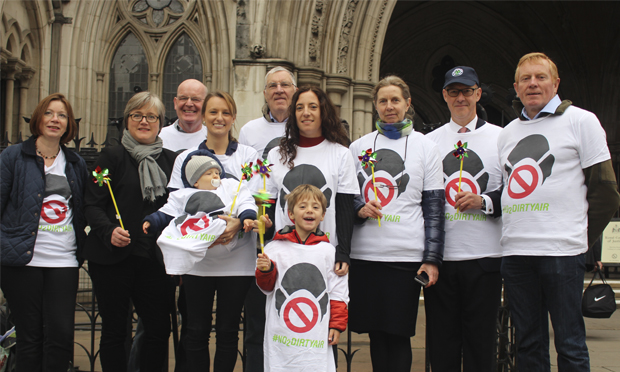‘Britain is waiting, Prime Minister’: ClientEarth wins toxic air High Court case

Air force: ClientEarth supporters were joined by Caroline Russell outside court. Photograph: ClientEarth
Environmental lawyers based in Hackney this week won their High Court case against the government over its “moral and legal failure” to tackle air pollution.
ClientEarth had already won its 2015 case in the Supreme Court, which ordered the government to come up with a plan to bring pollution down to legal levels “as soon as possible”.
But the law firm was unhappy with the “vague proposals” outlined by the Department for Environment, Food and Rural Affairs (Defra) last December and launched a second legal challenge which started on 18 October at the High Court.
Mr Justice Garnham agreed with ClientEarth that the Environment Secretary had failed to take measures that would bring the UK into compliance with the law “as soon as possible” and said that ministers knew that overly optimistic pollution modelling was being used.
ClientEarth chief executive James Thornton said: “I am pleased that the judge agrees with us that the government could and should be doing more to deal with air pollution and protecting people’s health. That’s why we went to court.
“The time for legal action is over. This is an urgent public health crisis over which the Prime Minister must take personal control. I challenge Theresa May to take immediate action now to deal with illegal levels of pollution and prevent tens of thousands of additional early deaths in the UK. The High Court has ruled that more urgent action must be taken.
“Britain is watching and waiting, Prime Minister.”
During the two day case, Green London Assembly Member Caroline Russell was outside the High Court to “express solidarity” with ClientEarth’s #NO2DirtyAir campaign.
She said: “The government has been woeful in its failure to deal with illegal levels of air pollution, and the situation is now reaching a crisis point.”
During evidence, the court heard that Defra’s original plans for a more extensive network of Clean Air Zones in more than a dozen UK cities had been watered down, on cost grounds, to five in addition to London.
Defra announced last December that it would introduce clean air zones in major cities, but Manchester, Glasgow and Liverpool are not required to have them.
ClientEarth air quality lawyer Alan Andrews said: “We hope the new government will finally get on with preparing a credible plan to resolve this issue once and for all. We look forward to working with Defra ministers on developing a new plan which makes a genuine attempt to achieve legal limits throughout the UK as soon as possible.
“We need a national network of clean air zones to be in place by 2018 in cities across the UK, not just in a handful of cities. The government also needs to stop these inaccurate Modelling forecasts. Future projections of compliance need to be based on what is really coming out of the exhausts of diesel cars when driving on the road, not just the results of discredited laboratory tests.”
A Defra spokesperson said: “We will now carefully consider this ruling, and our next steps, in detail.”
Commenting on the launch of a new consultation on how best to introduce the zones in key cities, environment minister Thérèse Coffey said:
“We need to tackle air pollution and creating clean air zones will improve the quality of life for people who live and work in our towns and cities, both now and in the future.
“Real progress has been made, but there is more to do, which is why we have also committed more than £2 billion to greener transport schemes since 2011.”
Hackney was earlier this year named as one of the boroughs to benefit from Mayor of London Sadiq Khan’s new pollution-busting scheme.
